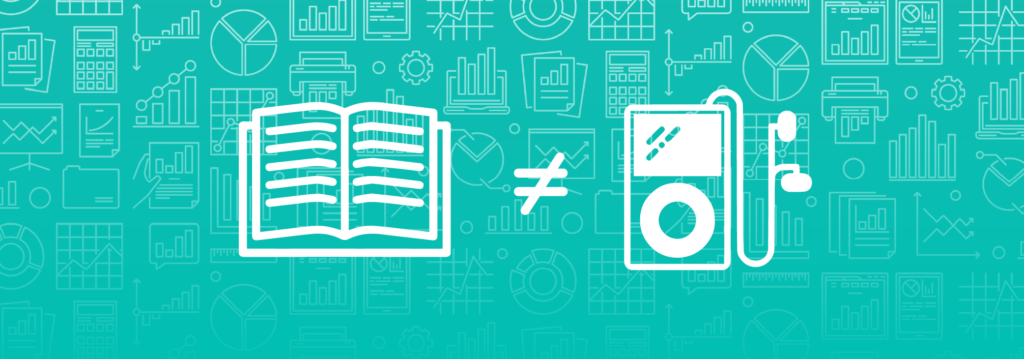
By Kristin Weir, MedeAnalytics
People like stories. We like to tell them. We like to read them.
Enterprise analytics is the story of a healthcare organization. Just like the chapters in a book, enterprise analytics takes “readers” from the beginning to the end, from chapter to chapter without interruption. Whether organizations are ready, enterprise analytics is the future of healthcare: It can bring together data about finances, operations, medical assessments, the revenue cycle and more.
“Successful businesses always maintain a constant conversation about the future: what lessons need to be operationalized today in order to avoid future irrelevance or worse, extinction?,” explains futurist Gerd Leonhard. “For one thing, it is essential to understand that everything that can be digitized, automated or virtualized, will be.”
Successful healthcare organizations understand the future of enterprise analytics is a book-like approach, not a Spotify playlist.
Using the book paradigm, enterprise analytics in healthcare should tell a story. In its current form, however, the enterprise analytics experience often doesn’t say much at all because of a lack of structure in the data caused by multiple, disparate solutions. Today’s analytics approach across the enterprise is more like a Spotify playlist. Rather than a cohesive set of chapters, enterprise analytics is disjointed and messy. Enterprise analytics is the hits, the one-hit wonders, and the also-rans. It skips from band to band, genre to genre and decade to decade with no discernable pattern. Each “song” is insulated from the next, which may be fun when it comes to reliving the past but doesn’t lend itself to cohesiveness or positive business and clinical impacts.
The enterprise analytics playlist, therefore, is an incomplete view of a healthcare organization’s business. In a report about data analytics, Deloitte investigates why enterprise analytics can be so difficult to implement well in a healthcare organization. It’s because many organizations, for a variety of reasons, including internal politics and a need for departmental domination, take the playlist approach.
“(C)ontrol and ownership of data can often be a very personal and highly political issue,” according to Deloitte. “Executives frequently make decisions within their own area of responsibility based on personal intuition and consensus, often because they lack access to good information or because it’s easier to rely on what has worked in the past in other organizations.”
Enterprise analytics needs to be more like a book if we expect to make a significant and positive change in healthcare.
Why Today’s Enterprise Analytics Is Playlist
Unfortunately, enterprise analytics continues to look and act more like a Spotify playlist than a book. Data is kept in a variety of stand-alone products and solutions that don’t, and, more often than not, can’t, communicate. These products, in turn, are sold by hundreds of companies to healthcare organizations.
“Currently, healthcare data are split among different entities and have different formats such that building an insightful, granular database is next to impossible,” according to the Brookings Institution. “These qualities greatly increase the cost of using data to provide value, even when all the relevant information has been recorded in some form.”
While enterprise analytics has a small, but growing footprint in the healthcare industry, today it’s built on multiple solutions that are all valuable on their own but can’t be reconciled. Healthcare organizations certainly are solving business problems using the solutions, but pulling the important insights from all of them into one view is nearly impossible without a considerable amount of time, effort and cost. Basically, it can’t be done. It’s nearly impossible to pull the parts of this data playlist into one cohesive story. Standing alone, they each tell their own story, but taken as a whole it’s an incomplete view. Like a single song, the data means something in an individual context, but not when we attempt to bring them together.
As the Brookings Institution puts it, “Despite the immense promise of health analytics, the industry lags behind other major sectors in taking advantage of cutting-edge tools.”
The cutting-edge tools are enterprise analytics for healthcare.
Write The Book With Enterprise Analytics
Framing enterprise analytics as a book offering that tells a linear story allows us to move away from the playlist model and provides the ability for all healthcare data solutions to tell a complete story.
To tell the story with enterprise analytics, clinical, financial and operational data must work together. This grouping allows healthcare organizations to track the effectiveness of every part of the business, chapter by chapter.
“By organizing resources so they can work across traditional boundaries new insights can be obtained at the enterprise level that cannot be developed in isolation,” explains Deloitte.
In our analogy, a book works across those traditional boundaries, while a Spotify playlist lives in isolation. The former helps healthcare organizations get an enterprise-wide view of its financial and clinical operations, the latter keeps information separated and allows understanding only among those who have access. “Structuring analytics in silos can limit analysts’ abilities to collaborate on broad, strategic initiatives or complex issues involving multiple areas of the business,” according to Deloitte.
Enterprise analytics can help solve organizational problems, create action plans and help staff resolve business and clinical issues. While challenges in healthcare are different and complex, enterprise analytics—and its inherent ability to be customized—is critical to creating solutions to business problems.
The changeover to enterprise analytics won’t happen overnight. “The slow pace of innovation reflects challenges that are unique to healthcare in implementing and applying ‘Big Data’ tools,” explains the Brookings Institution.
Nevertheless, we should start moving in the right direction. To better understand the business of healthcare in all its forms, we need a holistic approach that allows consistent examination of data to improve clinical, patient, financial and operational outcomes.
Get our take on industry trends
Why Predictive Analytics is the Answer to Healthcare’s Big Data Problem
By Scott Hampel Making improvements in healthcare data analytics has the potential to lead to significant cost savings and improved…
Read on...Unfamiliar Healthcare Players, Interoperability and Social Determinants Round Out 2020 Megatrends
By Scott Hampel, president of MedeAnaltyics We conclude our 2020 Megatrends with an exploration of new players entering healthcare, the…
Read on...More Megatrends: Price Transparency, Telehealth, Individualized Medicine
By Scott Hampel, president of MedeAnalytics Now that we’ve dealt with Megatrends one through three, we’re approaching the next set.…
Read on...2020 Megatrends: Consumerism, Data Privacy and Security, AI
With 2020 two weeks old, it’s becoming clear the data produced in the healthcare industry by providers, consumers and payers will power and propel our 9 megatrends. Healthcare data is the foundation on which we’re building everything from healthcare outreach for the underserved to new Internet of Things-based healthcare programs to treatments designed just for you.
Read on...


